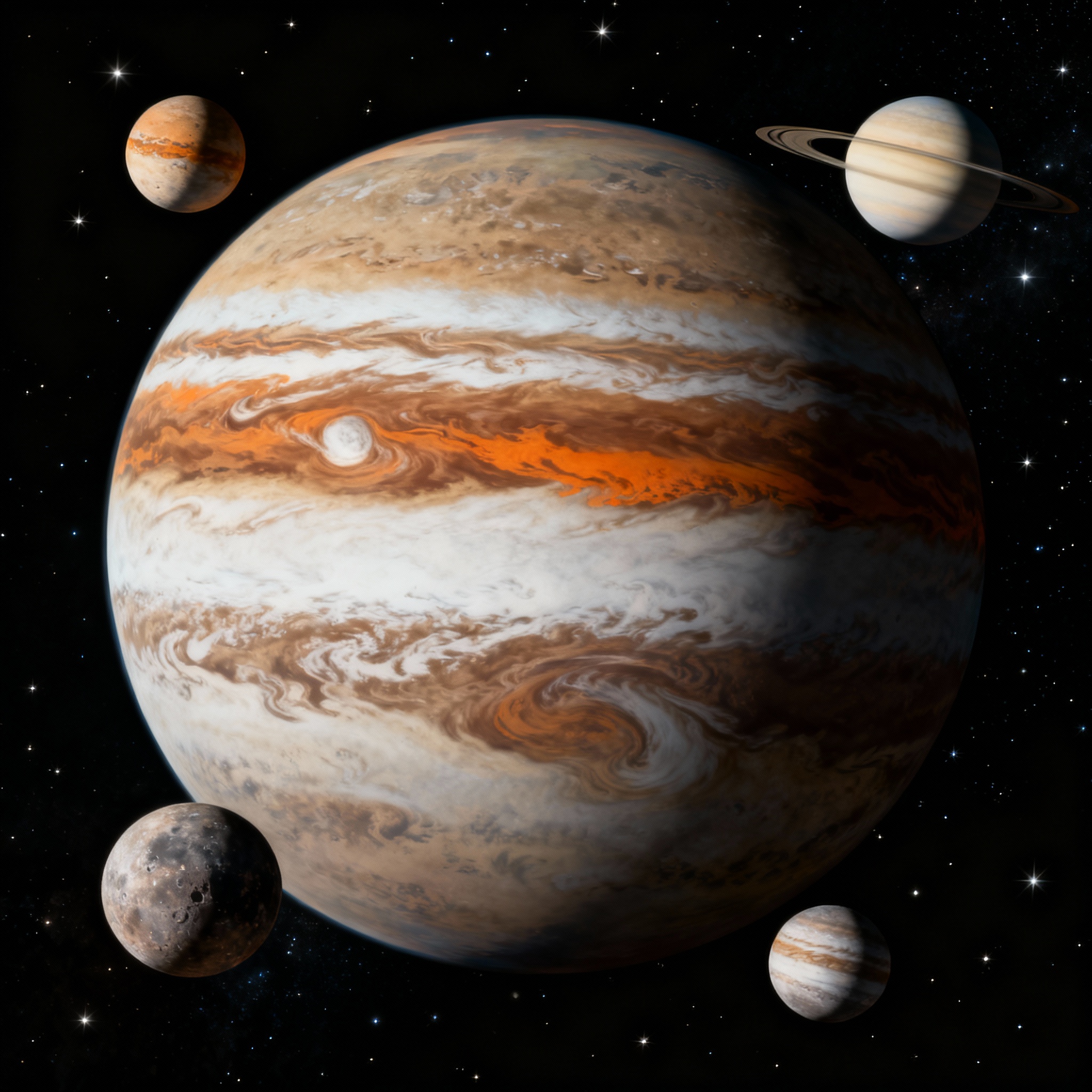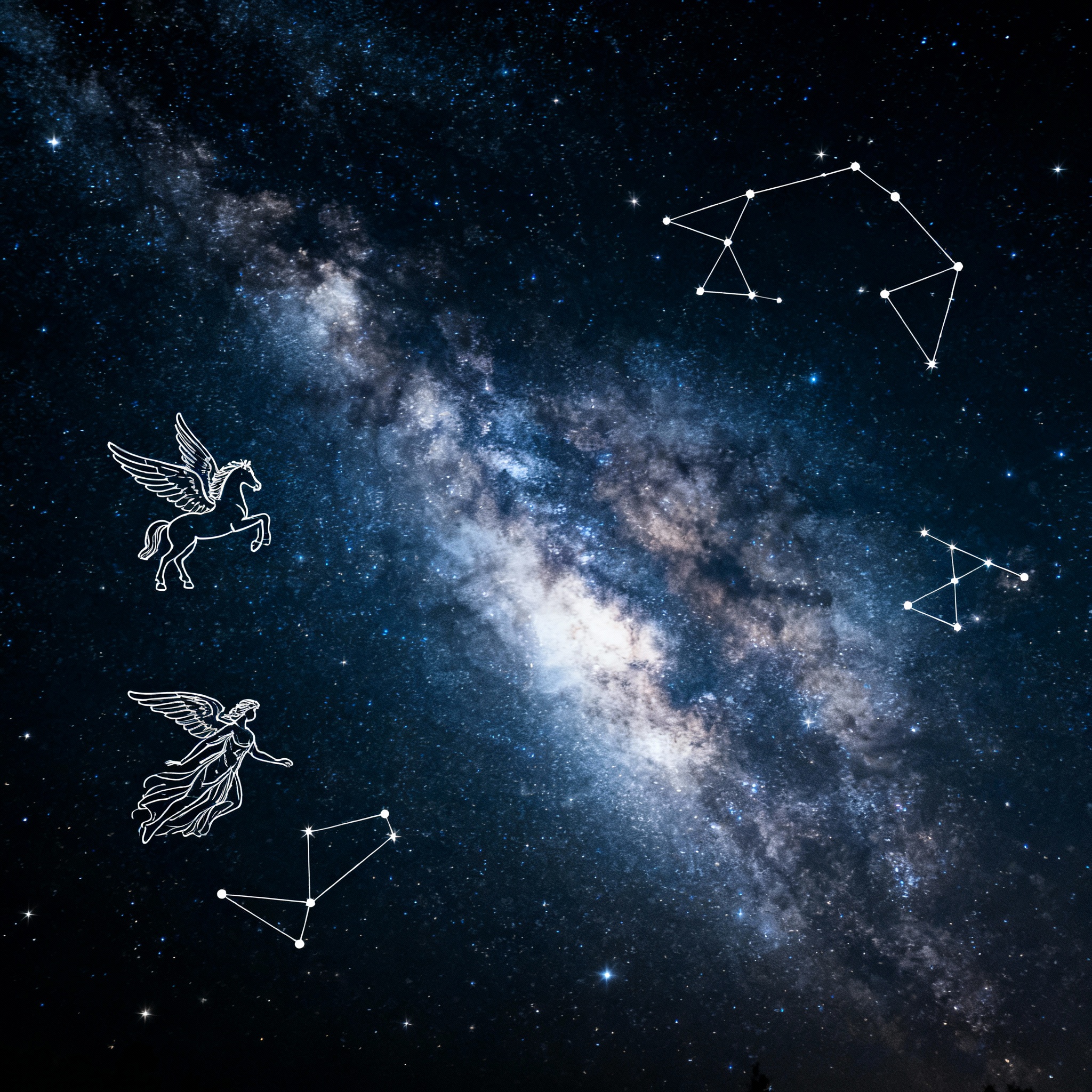Night Sky Guide
An Observer's Field Guide to the Indian Night Sky: October 2025
Published on October 2, 2025 by Nishant Gor

Welcome to your guide to the celestial theatre of October 2025. As the nights grow darker and the air turns pleasant, we are presented with a prime opportunity to look up and explore the cosmos. This month is a spectacular one, marked by a brilliant "Supermoon," exceptional views of our solar system's giant planets, and the peak of a major meteor shower under ideal conditions.
October's celestial ballet features the magnificent Harvest Moon, appearing larger and brighter than usual. In the planetary realm, the gas and ice giants—Saturn, Jupiter, Uranus, and Neptune—are all exceptionally well-placed for observation, offering a rare chance to tour the outer solar system in a single month. Capping it all off, debris from the famous Halley's Comet will streak across our skies during the Orionid meteor shower, which peaks on a moonless night, promising a fantastic display for dedicated observers.
Important Note for Observers in India: This guide provides a comprehensive overview of celestial events. While specific dates are noted, the exact time of events like occultations or transits can vary. Observers across India should always verify timings for their specific location and ensure they are referencing Indian Standard Time (IST) for planning.
This guide will navigate you through these highlights and more. Let's begin with a quick look at the month's key dates.
2.0 October 2025 Celestial Calendar: At-a-Glance
This section provides a quick, scannable list of the most notable celestial events for the month, perfect for planning your observing sessions ahead of time.
- October 2: Dwarf Planet Ceres reaches opposition, making it brighter and well-placed for observation with a telescope.
- October 6: Saturn's largest moon, Titan, transits across the planet's disc in the early morning hours.
- October 6-7: The Full Moon graces the sky. This is 2025's official Harvest Moon and also a Supermoon.
- October 8: The Draconid Meteor Shower reaches its peak, though viewing will be severely hampered by the bright light of the nearby Full Moon.
- October 10: In the morning sky, the waning Moon passes in front of, or occults, part of the famous Pleiades star cluster (M45).
- October 13: A double shadow transit occurs on Jupiter, with the shadows of both Io and Ganymede visible on the planet's cloud tops in the early morning.
- October 13: Titan disappears behind Saturn in an occultation event.
- October 13: The Moon reaches its Last Quarter phase.
- October 14: The waning crescent Moon makes a close approach to the Beehive Cluster (M44).
- October 19: Mars and Mercury appear in close proximity low on the western horizon, presenting a significant observational challenge.
- October 21: The New Moon provides the darkest skies of the month, ideal for deep-sky viewing.
- October 21: The Orionid Meteor Shower reaches its peak under excellent, moonless conditions.
- October 21: Titan performs another transit across Saturn's disc.
- October 29: The Moon reaches its First Quarter phase.
- October 30: The waxing gibbous Moon occults the star Gamma Capricorni, also known as Nashira.
With so many lunar events on the calendar, let's delve deeper into our closest celestial neighbour, the Moon.
3.0 The Moon: A Super Harvest Moon and More

The Moon takes centre stage in October's sky, playing a dual role for observers. It begins the month as a spectacular object in its own right—a brilliant Supermoon—and later provides key opportunities for occultation viewings. Conversely, its bright light will interfere with some observations, but its absence during the New Moon phase creates perfect conditions for the month's best meteor shower.
3.1. Lunar Phases for October
- Full Moon: October 7
- Last Quarter: October 13
- New Moon: October 21
- First Quarter: October 29
3.2. Special Feature: The Harvest Supermoon
The Full Moon on October 7th is a particularly special event. It earns the title of the 2025 Harvest Moon because it is the full moon that falls closest to the Northern Hemisphere's autumnal equinox. This unique timing has a noticeable effect on our sky. Around the Harvest Moon, the time difference between moonrise on successive nights is minimized, shrinking from the usual 50 minutes to as little as 15 minutes. This geometry historically provided farmers with extra twilight to continue their harvest.
Adding to the spectacle, this is also a Supermoon. This occurs when the full moon coincides with its perigee—its closest point to Earth in its elliptical orbit. The result is a Moon that can appear up to 14% larger and 30% brighter than a typical full moon, making for a truly stunning sight as it rises above the horizon.
3.3. Key Lunar Conjunctions and Occultations
- October 10: Occultation of the Pleiades: In the morning sky, the waning gibbous Moon will pass directly in front of the Pleiades star cluster (M45). While the Moon's brightness can overpower the stars, the encroaching dawn twilight may actually help by reducing the Moon's intense glare, balancing the view.
- October 14: Close Approach to the Beehive Cluster: The waning crescent Moon (36% illuminated) will be positioned just 1.2 degrees north of the centre of the beautiful Beehive Cluster (M44), offering a fine sight for binocular observers.
- October 30: Occultation of Nashira: The waxing gibbous Moon will pass in front of the star Gamma Capricorni, also known as Nashira. This is another excellent opportunity to witness the Moon's steady orbital motion against the background stars.
3.4. Featured Observing Target: The Fra Mauro Highlands
In honour of Apollo astronaut Jim Lovell, we turn our attention to the Fra Mauro Highlands. This geologically fascinating region was the intended landing site for the ill-fated Apollo 13 mission, which Lovell commanded and famously described as a "successful failure" after the crew returned safely against all odds. NASA deemed the area so important that it was selected again as the successful landing site for Apollo 14 in 1971.
While the landing sites themselves are far too small to be seen with amateur telescopes, the surrounding region is a superb target. The best time to observe is when the features are near the terminator—the line separating lunar day and night. This occurs 6 to 8 days after the Full Moon or 8 to 10 days after the New Moon, when long shadows create high-contrast views.
To locate the Fra Mauro formation, use the prominent craters Kepler and Copernicus as your primary landmarks. From there, look south towards the large crater Ptolemaeus. The Fra Mauro region lies between these guideposts, with the smaller but distinct crater Herschel nearby.
From the steady glow of the Moon, we now turn to the wandering lights of the planets.
4.0 Guide to the Planets
October 2025 offers a tale of two solar systems. The outer gas and ice giants put on a magnificent display, dominating the night sky. In stark contrast, the inner terrestrial planets are poorly positioned, presenting a true challenge for even the most dedicated observers.
4.1. Evening Sky Planets: Saturn Leads the Way

- Saturn: The jewel of the early evening sky, Saturn is already well above the eastern horizon after sunset. Having passed its opposition in September, it remains brilliantly illuminated and is ideally placed for observation all evening. Through a telescope, its famous rings appear nearly edge-on, a unique perspective that only occurs every 15 years. Look for its largest moon, Titan, which can be seen transiting the planet's disc on October 6 and October 21, and being occulted by the planet on October 13. Due to the shallow ring angle, observers can no longer see Titan's shadow transit the planet, making the transit of the moon's disc itself the primary observable event.
- Neptune: This is an excellent month to hunt for the solar system's most distant planet. Neptune is located very close to Saturn in the sky, making it just a "short hop away" for telescope users. Use Saturn as a guide to locate this faint, bluish world.
- The Challenging Inner Planets (Mars & Mercury): Both Mars and Mercury are technically evening planets this month, but they are extremely low on the western horizon after sunset. Their faintness and poor positioning make them very difficult targets. For a true challenge, dedicated observers can attempt to spot them in close proximity on October 19th.
4.2. Late Night & Morning Sky Planets: Jupiter, Uranus, and Venus
- Jupiter: The brilliant king of the late-night and pre-dawn sky, Jupiter shines brightly high in the constellation Gemini. After years of being low on the horizon, its placement so high in the sky is a welcome change for Northern Hemisphere observers. This is because Jupiter, in its ~12-year orbit, is approaching an equinox in 2026, which places it high in constellations like Gemini. Even small telescopes will reveal its dynamic cloud belts and its four large Galilean moons. A special event occurs on the morning of October 13th, when a double shadow transit will be visible, with the shadows of both Io and Ganymede simultaneously cast upon Jupiter's face.
- Uranus: The ice giant Uranus is exceptionally well-placed for observation. Its location just south of the famous Pleiades star cluster makes it much easier to find than usual. This month, it reaches a magnitude of +5.6, meaning that from a truly dark site, it is theoretically visible to the naked eye as a faint, star-like point.
- Venus: The unmistakable, brilliant "Morning Star" can be found gleaming low in the southeast before dawn. While its brightness is impossible to miss, its period of visibility is shortening throughout October as it moves closer to the Sun from our perspective.
From the steady light of planets, we now turn our attention to the fleeting streaks of meteor showers.
5.0 Meteor Showers: Catching Halley's Comet Dust
October offers two distinct meteor shower opportunities, both originating from the dusty trails of famous comets. However, their viewing prospects could not be more different. The Orionids are set for a spectacular show under dark skies, while the Draconids will be almost entirely lost in the glare of the Moon.
5.1. The Main Event: The Orionid Meteor Shower (Peak: October 21st)
The Orionids are the month's premier meteor shower, produced as Earth passes through the stream of debris left behind by the one and only Halley's Comet. This shower is known for producing fast-moving meteors, often leaving persistent trails, at a rate of about 20 meteors per hour under ideal conditions (Zenithal Hourly Rate).
Crucially, the viewing conditions for 2025 are excellent. The shower's peak on the night of October 20-21 coincides perfectly with the New Moon, guaranteeing a dark, moonless sky for the entire night. For the best experience, find a dark location away from city lights and allow your eyes at least 20 minutes to fully adapt. The best time to watch is from late evening on October 20th into the early morning hours of October 21st, looking generally towards the constellation Orion as it climbs higher in the sky.
5.2. The Draconid Meteor Shower (Peak: October 8th)
Originating from debris trailing the comet 21P Giacobini-Zinner, the Draconids are a much more minor shower, with an expected rate of up to 10 meteors per hour. The shower's prospects are very poor this year, as its peak occurs just one day after the Full Moon. The brilliant light from the Harvest Supermoon will wash out all but the very brightest meteors, making them nearly impossible to see.
Let's now move from these temporary showers to the permanent star patterns of the autumn sky.
6.0 A Tour of the Autumn Constellations
With the nights drawing in, we invite you on a guided tour of the prominent constellations and deep-sky objects that define the October evening sky.
6.1. The Great Square and the Flying Horse (Pegasus)
Look towards the eastern sky to find a massive and easily recognizable asterism: the Great Square of Pegasus. This large box of four medium-brightness stars forms the body of the mythical flying horse. Interestingly, the star in the northeast corner, Alpheratz, officially belongs to the neighbouring constellation of Andromeda. To find a celestial treasure, use the stars Baham and Enif, which mark the horse's head, to star-hop towards M15, a bright and beautiful globular cluster.
6.2. The Chained Princess and Her Galaxy (Andromeda)
Stretching away from the Great Square, beginning at the star Alpheratz, is the constellation Andromeda. This pattern is home to the most famous deep-sky object of all: the Andromeda Galaxy (M31). To find it, follow this simple star-hopping guide:
- Start at Alpheratz, the corner star shared with Pegasus.
- Move to the next bright star along the chain of Andromeda, named Mirach.
- From Mirach, make a sharp 90-degree turn upwards towards a fainter star. The Andromeda Galaxy will appear as a small, faint, hazy patch of light just to the upper right of this star.
When you see this smudge of light, you are gazing at the most distant object visible to the unaided human eye, an entire galaxy of stars located 2.5 million light-years away.
6.3. The Hunter Rises (Orion)
As the night progresses, the magnificent constellation Orion begins its ascent in the east around midnight. Notice the striking colour difference between its two brightest stars: the reddish supergiant Betelgeuse in its shoulder and the brilliant blue-white star Rigel at its foot. Below the famous three stars of Orion's Belt hangs his "sword." The fuzzy-looking star in the middle of the sword is not a star at all, but the glorious Orion Nebula (M42), the nearest major star-forming region to Earth and a breathtaking sight in any telescope.
6.4. The Summer Triangle's Legacy (Cygnus and Vulpecula)

Though we are deep into autumn, the prominent Summer Triangle asterism is still visible high overhead in the evening. Within it lies the constellation Cygnus the Swan. Its most beautiful feature is the star Albireo, which marks the swan's beak. Viewed through any telescope, it resolves into a stunning double star with brilliantly contrasting golden and turquoise components. Nearby lies the faint constellation Vulpecula, the Fox. While its stars are underwhelming, it is home to one of the sky's finest objects: the Dumbbell Nebula (M27), a glowing remnant of a long-dead star.
7.0 Concluding Your October Night Watch
October 2025 presents a rich tapestry of celestial events for observers of all levels. From the brilliant light of the Harvest Supermoon and the steady watch of the giant planets to the fleeting streaks of Halley's Comet dust and the faint glow of a distant galaxy, there is a wealth of beauty and wonder to be found. Take a moment this month to step outside, look up, and connect with the grander universe.
Wishing you clear skies for all of your observing this month.